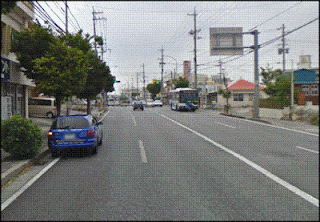 |
| A normal residential street on Okinawa. Source GoogleMaps |
There are many differences, both obvious and subtle, to how people drive on Okinawa.
One of the obvious differences is that people drive on the left side of the road, compared to driving on the right side in America. The steering wheel is also on the left side of the vehicle, making it sometimes a little strange and unfamiliar.
Upon traveling from Japan to the States, or the opposite, I have often tried to get into the wrong side of the vehicle, often to the amusement of those with me.
The Three Car Rule
A more subtle driving rule on Okinawa is sometimes called the 'three care rule'.
At almost any intersection on Okinawa when the light changes to red, one can often notice about three cars continuing through the intersection. It is hard to tell where this started, or why it is done, but police rarely stop people for running red lights. (that doesn't mean they won't!)
Typically there is a few seconds delay between a light for one direction turning red, and the light for the other direction turning green. Perhaps people started running the red lights because no one was in the intersection anyway.
No matter the source of this interesting occurrence, it is important to be aware of it for this reason: You may not want to stop at yellow lights, because someone could rear-end you thinking you would go through the light.
This is especially important if there is a large truck, such as a dump truck, following behind you. If this is the case, it might be in your best interest to run the light.
The good new is, people coming from the other direction where the light has just turned green, are usually very accommodating and allow late light runners a little leeway.
Stopping on the Shoulder, when there is no Shoulder
 |
| An Example of a Car Parked on the Road. Source GoogleMap |
Yet in Japan, it is common to stop in this halfway-in-the-shoulder, halfway-in-the-road position. In fact, it seems that, as long as you put the hazard lights on, you can stop just about anywhere on the road.
Many people will stop and put their hazard lights on if they receive a phone call. A law was passed int he last few years making it illegal to talk on the phone and drive, so it is common to see cars partially pulled over, with people on the phone.
In these situations, simply look for a way to drive around the parked car. If there is no easy route around, then just wait patiently. Okinawan's don't tend to be impatient when it comes to driving, and they are usually very understanding when it comes to unnatural traffic situations.
 |
| A busy intersection on Okinawa. Source GoogleMaps |
This isn't really an unspoken traffic rule, but it is something to keep in mind. Japanese, especially Okinawans, are quite bad at merging. For some reason they struggle with the idea of yielding and joining traffic. This is usually not a problem as most roads have long enough merging areas and not too much traffic. But in a few places I have noticed, one should really be wary.
Conclusions - Take it Easy
Traffic on Okinawa can be a bit unnerving with people changing lanes quickly, stopping, and many small streets. But if you avoid trying to be in a rush, and enjoy the tropical island around you, it should be fun and entertaining to watch how people follow some of these interesting unspoken traffic rules.

Hi Peter,
ReplyDeleteCan i check if the steering wheel is on the left hand side or the right hand side of the vehicle?
How about parking fees and charges? What are the typical rates in a mall or parking by the side of the road?
J.J. Mak - In Japan, as you might already know, cars drive on the left side of the road, but the steering wheel is on the right side of the car.
DeleteOn Okinawa, parking is usually not a problem, so at malls it is almost always free. Some places that have limited parking, such as the airport, charge a few hundred yen per hour, or 2-3 USD per hour. It is very common to park on the side of the street, and it is free.
In some cities such as Tokyo, parking is a different story. It is very expensive, such as 300 yen per 20 minutes. It can be very hard to find reasonable parking in very large cities, so plan ahead if you are going there.
Thanks for your comment!